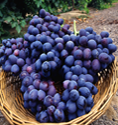How Plants Protect Us
Unmasking the Secret Power of Phytochemicals
Rosemary, the fragrant herb that enlivens roast chicken and other favorites, and turmeric, the mainstay spice of curry dishes, contain powerful natural compounds that, in test tubes, can kill cells of a childhood cancer. What’s more, grapes, strawberries, and other familiar fruits—and some vegetables—also have chemicals that can destroy the cells of this cancer, known as “acute lymphoblastic leukemia.”
Susan J. Zunino, an Agricultural Research Service molecular biologist, leads the nutrition-focused research that has resulted in these first-ever findings. She’s investigating the health-imparting effects of plant chemicals, or phytochemicals, using laboratory cultures of both healthy human blood cells and cancerous ones as her models.
Zunino is based at the agency’s Western Human Nutrition Research Center in Davis, California, about an hour’s drive northeast of San Francisco. She’s collaborating in the investigations with molecular biologist David Storms, at the Davis center; Jonathan Ducore, at the University of California-Davis Cancer Center; and Navindra Seeram, at the University of California-Los Angeles.
Zunino’s pioneering studies, published in Cancer Research and Cancer Letters, reveal the previously unknown ability of about a half-dozen phytochemicals to stop growth of this type of leukemia. The findings are of interest to cancer researchers and to nutrition researchers exploring the health benefits of compounds in the world’s edible fruits, vegetables, herbs, and spices.
|
|
Death of Leukemia Cells: How Do Phytochemicals Triumph?
For the most part, scientists don’t yet have all the details about how phytochemicals bolster healthy cells and battle harmful ones. That’s true even for better-known phytochemicals such as the resveratrol in red grapes, blueberries, and some other fruits.
Zunino’s investigations provide some new clues about how phytochemicals attack cancer cells. She has studied carnosol from rosemary, curcumin from turmeric, resveratrol from grapes, and ellagic acid, kaempferol, and quercetin in strawberries. The work demonstrated the ability of these phytochemicals to kill the acute lymphoblastic leukemia cells and also suggested ways in which the compounds might do that.
For example, Zunino and colleagues showed that the phytochemicals interfere with the orderly operations of mitochondria, the miniature energy-producing power plants inside cells. Without energy, cells die.
Mitochondria exposed to resveratrol and the other phytochemicals became inoperative. But more work is needed to fully understand how the phytochemicals achieved that. And the team wants to know more about the phytochemicals’ other modes of action that resulted in the cancer-cell death.





